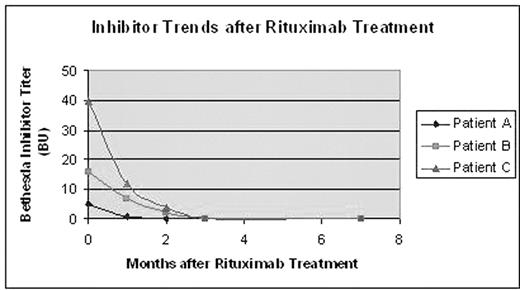Abstract
Inhibitor development in congenital hemophiliacs can be clinically catastrophic. Immune tolerance induction therapy has previously been the standard of care in eradicating inhibitors; however due to a multitude of factors, this may not be applicable in certain patients. The role of Rituximab is receiving more attention in this subset of patients. In this abstract, we report that treatment with Rituximab led to successful eradication of high-titer inhibitors in 3 patients with mild to moderate hemophilia A who developed inhibitors after receiving intensive treatment with recombinant Factor VIII (FVIII).
Patient Characteristics: Three patients, aged 50–70, with baseline FVIII levels of 2–9%, developed inhibitors after recombinant Factor VIII infusion. Patient A was treated with continuous infusion FVIII for a post-surgical hemarthrosis for approximately 7 days. Patient B received bolus dose FVIII for a GI bleed for at least 10 days, and Patient C received bolus dose FVIII for knee replacement for 10 days. Factor VIII inhibitors were detected in these patients after one month. None of these patients had been treated with immune tolerance previously or had known inhibitors. Each patient received Rituximab 375mg/m2 every week for 4 weeks total. During and after treatment, FVIII levels and Bethesda inhibitor titers (BU) were monitored.
Results: All three patients had eradication of their inhibitors (Figure 1) and return of their FVIII levels to baseline by six months post-treatment. Notably, patient C’s inhibitor peak was 117 BUs, 7 months prior to Rituximab treatment. Patient C’s initial response to Rituximab has been previously reported at ASH in abstract form. We now report that 4 years later, this patient has had a recurrence of his inhibitor after monoclonal FVIII for a contralateral knee replacement but with a peak titer of only 2 (Table 1).
Inhibitor Trends after Rituximab Treatment
Bethesda Inhibitor Titer (BU) per Month (*) after Receiving Rituximab
| . | 0* . | 1 . | 3 . | 6 . | 36 . | 48 . | 51 . |
|---|---|---|---|---|---|---|---|
| NA=Not applicable as data has not matured yet | |||||||
| Patient A (BU) | 5 | 0.7 | 0 | 0 | NA | NA | NA |
| Patient B (BU) | 17 | 7 | 2 | 0 | NA | NA | NA |
| Patient C (BU) | 40 | 4 | 0 | 0 | 0 | 2 | 0.5 |
| . | 0* . | 1 . | 3 . | 6 . | 36 . | 48 . | 51 . |
|---|---|---|---|---|---|---|---|
| NA=Not applicable as data has not matured yet | |||||||
| Patient A (BU) | 5 | 0.7 | 0 | 0 | NA | NA | NA |
| Patient B (BU) | 17 | 7 | 2 | 0 | NA | NA | NA |
| Patient C (BU) | 40 | 4 | 0 | 0 | 0 | 2 | 0.5 |
Conclusion:
Inhibitors in patients with mild-moderate hemophilia differ from those with severe FVIII deficiency, behaving more like the autoantibodies seen in patients with spontaneous FVIII inhibitors. In support of this idea, we successfully treated high titer inhibitors which developed in 3 patients with baseline FVIII levels of 2–9%. All three patients had prompt resolution of their inhibitor titers during the course of therapy, with return of their baseline FVIII levels. Historically, patients with mild-moderate hemophilia treated at the Harold R. Roberts Comprehensive Hemophilia Center at the University of North Carolina were treated either with immune tolerance induction or by bypass agents alone, with inhibitor eradication taking months to years (data not shown). While performance of larger prospective trials would be ideal, the small number of patients with this condition limits the ability to perform these trials. Our findings, in combination with other case series from other institutions, reveal a promising alternative for prompt and reliable treatment in mild-moderate hemophiliacs with inhibitors.
Disclosures: Rituximab for the use of treatment of inhibitor for patients with congenital hemophilia. This has been well documented in the use of patients with acquired hemophilia [Stasi R, et al. Blood. 2004 June 15; 103(12):4424-8].


